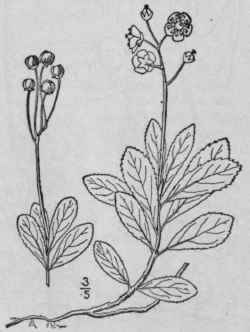3. Chimáphila Pursh, Fl. Am. Sept. 279, 300. 1814
Description
This section is from the book "An Illustrated Flora Of The Northern United States, Canada And The British Possessions Vol2", by Nathaniel Lord Britton, Addison Brown. Also available from Amazon: An Illustrated Flora of the Northern United States, Canada and the British Possessions. 3 Volume Set..
3. Chimáphila Pursh, Fl. Am. Sept. 279, 300. 1814
Perennial herbs, with decumbent stems, ascending leafy branches, the leaves opposite, or verticillate, coriaceous, evergreen, short-petioled and serrate, and spreading or nodding white or purplish flowers in corymbs or umbels. Pedicels mostly bracteolate. Calyx 5-cleft, or s-parted, persistent. Petals 5, concave, nearly orbicular, sessile, spreading or recurved. Stamens 10, similar to those of Pyrola, the filaments usually somewhat pubescent. Ovary globose, 5-lobed, 5-celled; ovules numerous in the cavities; style very short, obconic; stigma large, orbicular, 5-crenate. Capsule erect, globose, 5-lobed, 5-celled, loculicidally 5-valved from the top, the valves not woolly on the margins. Seeds numerous, minute, the testa reticulated, produced at each end. [Greek, winter-loving, from its evergreen leaves.]
About 6 species, natives of North America, Mexico, Santo Domingo and northeastern Asia. Besides the following another occurs on our Pacific Coast. Type species: Chimaphila maculata (L.) Pursh.
Leaves lanceolate, mottled with white. | 1. | C. maculata. |
Leaves spatulate or cuneate-oblanceolate, bright green. | 2, | C. umbellata. |
1. Chimaphila Maculàta (L.) Pursh. Spotted Wintergreen
Fig. 3206
Pyrola maculata L. Sp. Pl. 396. 1753.
C. maculata Pursh, Fl. Am. Sept. 300. 1814.
Stem extensively trailing, creeping or horizontally subterranean, sending up both sterile and flowering branches 3'-10' high. Leaves lanceolate, ovate-lanceolate, or the lower much shorter and ovate, acute or acuminate at the apex, rounded or narrowed at the base, sharply serrate with rather distant teeth, dark green and mottled with white along the veins, 1' - 3' long, 3"-12" wide below the middle; flowers few, corymbose or umbellate, white or pinkish, 6"-10" broad; peduncle and pedicels puberulent; filaments villous at the middle; capsules erect, depressed-globose, about 4" in diameter.
In dry woods, Maine and Ontario to Minnesota, south to Georgia and Mississippi. Ascends to 4200 ft. in North Carolina. June-Aug. Spotted pipsissiwa. Rheumatism-root. Dragon's-tongue. Wild arsenic. Ratsbane.

2. Chimaphila Umbellàta (L.) Nutt. Pipsissewa. Prince's Pine
Fig. 3207
Pyrola umbellata L. Sp. Pl. 396. 1753.
Chimaphila corymbosa Pursh, Fl. Am. Sept. 300. 1814.
Chimaphila umbellata Nutt. Gen. 1: 274. 1818.
Similar to the preceding species, the branches commonly stouter, sometimes 1° high and usually more leafy. Leaves spatulate or cuneate-oblanceolate, obtuse or acutish at the apex, sharply serrate, bright green and shining, not mottled, 1-2 1/2' long, 3"-12" wide above the middle; flowers several, umbellate or subcorymbose, white or pinkish, commonly smaller than those of the preceding species, usually marked by a deep pink ring; filaments ciliate; capsule 3"-4" in diameter.
In dry woods, Nova Scotia to British Columbia, south to Georgia, Mexico and California. Mountains of Santo Domingo. Also in Europe and Asia. Bitter wintergreen. Pine-tulip. Ground-holly. Bitter-sweet. Noble pine. Love-in-winter. King's-cure. June-Aug.

Continue to:


